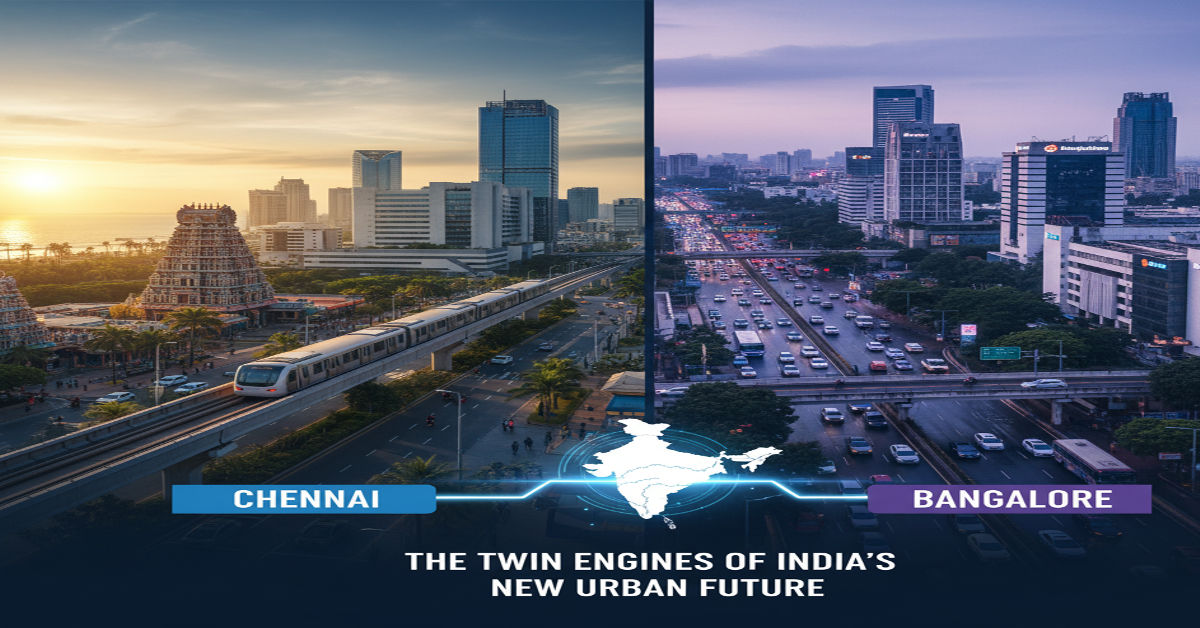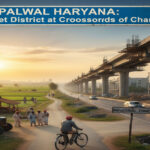When people debate the future of India’s cities, one question always surfaces **Chennai or Bangalore—**which better defines modern urban India? Within that choice lies the story of two metropolises that mirror the nation’s transformation one a coastal manufacturing powerhouse rooted in tradition, the other a high-altitude digital capital racing toward tomorrow.
Over the past three decades, both Chennai and Bangalore have evolved into global reference points. Chennai—formerly Madras—anchors India’s automobile, health, and cultural industries. Bangalore—officially Bengaluru—powers the country’s software, startup and innovation economy. Together, they illustrate how urban India is rewriting global definitions of work, creativity, and growth.
In this feature, we explore the economic, technological, and human dynamics that connect and distinguish these two southern giants. We examine how education, finance, lifestyle, and governance shape them; how each city negotiates infrastructure strain; and what their trajectories tell us about India’s next decade.
The comparison isn’t about rivalry—it’s about rhythm. Chennai moves to a classical beat, Bangalore to an improvisational one. Yet both are indispensable verses in the song of a country redefining modernity.
Economic Engines in Motion
Chennai or Bangalore—each city fuels a different side of India’s growth spectrum.
| City | Core Strength | Emerging Sector | Key Challenge |
| Chennai | Automobile manufacturing, healthcare, logistics | Fintech, green mobility | Climate resilience, water management |
| Bangalore | Technology, startups, R&D | AI, health-tech, crypto services | Infrastructure, congestion |
Bangalore’s technology workforce exceeds one million professionals, making it a global node for software development and artificial intelligence. Chennai, on the other hand, hosts India’s “Detroit corridor,” producing vehicles for companies like Hyundai, Ford, and BMW while nurturing a thriving hospital ecosystem.
Both cities attract substantial foreign investment and skilled migration. The difference lies in tempo: Bangalore moves at the speed of digital disruption; Chennai grows through steady, engineered precision.
The Technology Divide and the Convergence
Bangalore’s identity is built on innovation. Its neighborhoods—Whitefield, Koramangala, Indiranagar—are home to thousands of startups experimenting with AI, data, and financial platforms. Venture capital flows easily, and co-working spaces pulse late into the night.
Chennai, however, has begun closing that gap. Its engineering colleges feed a growing number of IT and fintech companies. The rise of cloud computing and logistics automation has allowed Chennai’s traditional industries to modernize without losing their manufacturing DNA.
According to analysts, this convergence is crucial. “The next decade won’t be about Chennai or Bangalore competing,” says Ravi Narayan, technology mentor and former CEO of T-Hub. “It’ll be about collaboration—Bangalore designing digital tools that Chennai’s factories and ports actually use.”
That mutual reinforcement—digital meets physical—is shaping South India’s new economic map.
Education and Talent Pipelines
Neither city’s rise would be possible without education. Chennai’s institutions—Indian Institute of Technology Madras, Loyola College, and Anna University—produce some of the country’s finest engineers and scientists. Bangalore counters with the Indian Institute of Science, IIM-Bangalore, and countless specialized universities.
Together, they form India’s largest continuous talent corridor. Students often study in one city and work in the other. Professors shuttle between conferences across both metros. “It’s a south-Indian brain-loop,” jokes Dr. Vikram Kumar, sociologist at the National Institute of Advanced Studies. “Whether you’re in Chennai or Bangalore, you’re swimming in the same talent pool.”
This academic density also fuels a culture of experimentation—research incubators, student startups, and civic hackathons. Knowledge is not siloed; it’s social.
Lifestyle, Culture and Identity
Here the contrast becomes visible—and delightful.
Chennai wakes early. Its rhythm is temple bells, classical music, and filter coffee by sunrise. Tradition anchors the day: a Carnatic concert, a movie premiere, or a family lunch under ceiling fans that hum to the monsoon.
Bangalore, by contrast, hums into the night. The city thrives on conversation—tech meetups, craft beer, art installations, and jazz sessions in old bungalows. It’s freer in dress, language, and tempo.
Yet both share a cosmopolitan empathy. In Chennai or Bangalore, migrants find home through shared ambition. A Delhi marketing graduate, a Kerala musician, and a Tamil coder may all meet at the same café, bound by Wi-Fi and optimism.
| Aspect | Chennai | Bangalore |
| Social vibe | Traditional, disciplined | Cosmopolitan, experimental |
| Food culture | Seafood, South Indian staples | Global fusion, cafes, breweries |
| Nightlife | Restrained but evolving | Vibrant and diverse |
| Climate | Hot, humid, coastal | Cooler, elevated plateau |
This duality defines southern India’s urban magnetism—heritage and modernity coexisting without erasing each other.
Infrastructure and Urban Realities
Rapid growth has tested both cities’ infrastructure.
In Chennai, rising sea levels and heavy monsoons challenge flood management. In Bangalore, uncontrolled real-estate expansion clogs roads and strains drainage. Each city’s planners face different demons: Chennai must protect its coast; Bangalore must breathe through its traffic.
Yet citizens are far from passive. Tech workers in Bangalore have created civic apps to report potholes and waste, while Chennai’s NGOs collaborate with the municipal body to restore lakes and wetlands.
“People always ask which city is better—Chennai or Bangalore,” says Lalitha Rao, urban planner. “But the real story is that both cities now have data-literate citizens who understand governance as participatory. That’s revolutionary for India.”
Health, Work and the Human Cost of Growth
Economic energy has a price. Professionals in both cities face rising stress, sedentary lifestyles, and air-quality issues. Bangalore’s start-up pace leads to burnout; Chennai’s heat and humidity pose their own challenges.
Healthcare access, however, is robust. Chennai remains India’s medical-tourism capital, drawing patients from across Asia. Bangalore’s hospitals lead in cardiology, fertility, and digital diagnostics.
“The urban Indian disease is time poverty,” warns Dr. Arun Menaka, cardiologist in Bangalore. “It doesn’t matter if you live in Chennai or Bangalore—if you’re always rushing, you’re always at risk.”
Wellness culture is spreading in response—yoga studios, weekend treks, meditation centers, and the rediscovery of local diets.
Business and Finance: The Southern Shift
Corporate India is tilting southward. Global firms base manufacturing near Chennai’s ports and R&D near Bangalore’s tech parks. Financial institutions are setting up satellite offices in both cities to tap regional clients.
The fintech boom has blurred boundaries. A startup may register in Bangalore, employ engineers in Chennai, and serve customers nationwide. Blockchain experimentation is cautious but growing, with Chennai universities now offering specialized courses.
This networked economy turns the “Chennai or Bangalore” question into a false binary. They function less as rivals and more as symbiotic nodes in India’s innovation chain.
Governance and Policy
Both cities wrestle with bureaucracy, yet each offers lessons in governance. Chennai’s municipal corporation—one of the oldest in the world—favors procedural rigor. Bangalore’s patchwork of agencies, though fragmented, often pilots digital solutions first.
The state governments of Tamil Nadu and Karnataka now compete for green investment, electric-vehicle manufacturing, and AI hubs. That rivalry, when healthy, drives reform. “If Delhi is the political capital and Mumbai the financial one, then Chennai or Bangalore together represent India’s intellectual capital,” notes policy analyst Meera Subramanian.
For urban India, their experiments in public transport, renewable energy, and e-governance could become templates for a new national model.
The Cultural and Creative Economies
Music, film, and fashion have long been Chennai’s soul. The Tamil film industry—Kollywood—produces hundreds of movies a year and increasingly collaborates with streaming platforms. Bangalore, by contrast, is defining a fresh creative economy built around design, gaming, and live art.
Both attract younger audiences seeking authenticity. Musicians tour both cities in the same weekend; brands test products in both markets. As media digitizes, their cultural ecosystems are merging faster than their highways.
Conclusion
The debate over Chennai or Bangalore is no longer about superiority; it’s about synergy. Chennai anchors with heritage, discipline, and industrial precision; Bangalore accelerates with imagination, networks, and software.
If India’s growth were a symphony, Chennai would provide the rhythm section—steady, grounded, essential—while Bangalore would play the improvisational solos that capture the world’s attention. Both are needed for harmony.
Their stories converge on one truth: India’s urban future will be written not by megacities alone but by the interdependence between them. Whether you sip coffee under Chennai’s coastal humidity or in Bangalore’s monsoon mist, you’re tasting the same spirit—resilience, reinvention, and restless ambition.
FAQs
1. Which city is better for jobs—Chennai or Bangalore?
Bangalore leads in tech and startups; Chennai excels in manufacturing and healthcare. Choice depends on career field and lifestyle preference.
2. Which is more affordable to live in?
Chennai generally offers lower housing costs, while Bangalore provides more entertainment and global work exposure.
3. Which has better infrastructure?
Chennai’s roads and metro system are more planned, but Bangalore is expanding rapidly with smart-city projects.
4. Is Bangalore’s weather really better?
Yes. Its higher elevation keeps it cooler year-round, while Chennai’s coastal humidity is intense but stable.
5. Will Chennai or Bangalore dominate the next decade?
Neither alone—together, they will drive India’s southern economic and cultural resurgence.







